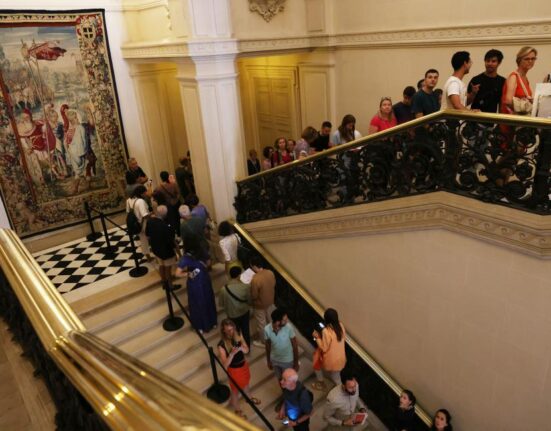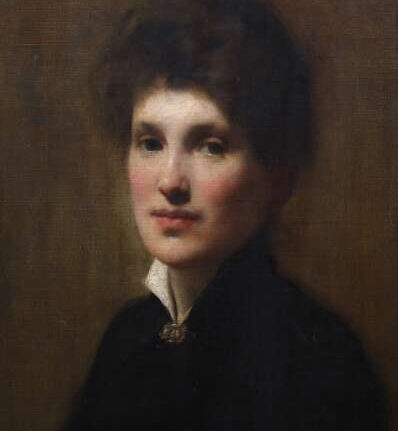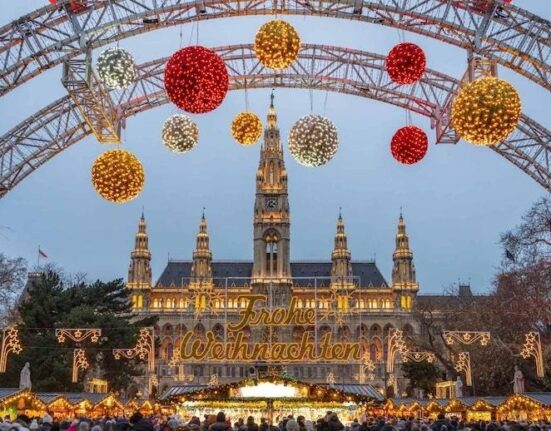
The fourth floor of The American Art Fair extends up to the fifth floor, where Avery Galleries and Thomas Colville Fine Art were situated. Chenyu Huang photo for The American Art Fair.
Review & Onsite Photos by Madelia Hickman Ring
NEW YORK CITY — For art lovers in or around New York City, mid-May is top-heavy with art auctions and shows, whether powerhouse previews at Christie’s and Sotheby’s, the glittering international art fair at the Park Avenue Armory that is The European Fine Art Fair (TEFAF), contemporary-art based shows Frieze NY, Focus New York, the New Art Dealers Alliance (NADA) show and the Future Fair, to name just a few.
A “must” on the list of any serious collectors and connoisseurs of art by non-living American artists was the jewel-box of a show, The American Art Fair (TAAF), which celebrated its 16th edition May 13-16 at the Bohemian National Hall, its home for the past 13 years. Long recognized by its high caliber of dealers and works, the fair is managed by the indefatigable Catherine Sweeney Singer, who reported an enthusiastic and buying crowd, with a record number of works sold on the floor of the show and more sales likely to be finalized in post-show follow up.
“When the fair closed, we had more than 50 reported sales — the highest number of sales during the fair, ever — and sales continue. The American Art Fair has, as our exhibitors know, a ‘long life,’ with follow up in the weeks after the fair ends to complete sales to museums and collectors. This year, over 100 of the more than 500 guests at our preview were museum curators and directors, many with groups of patrons. With museum-quality works in an elegant, landmarked venue, The American Art Fair attracts serious buyers and is accessible for potentially serious buyers who want to explore; unlike most fairs, we do not charge admission. Accessibility — access — also means being able to consult with the fair’s 17 exhibitors and their colleagues, who comprise the nation’s the greatest concentration of knowledge about Nineteenth and Twentieth Century American art.”

Thomas Colville Fine Art, Guilford, Conn., had a lofty vantage point from the fifth floor.
Additionally, Sweeney Singer noted that more works by women and artists of color — all currently in demand by museums and collectors — were exhibited this year than previously.
This year, the fair also made history when, in an art historical homecoming of sorts, it introduced classic American folk art from Woodbury, Conn.-based dealers David Schorsch and Eileen Smiles. The roots of collecting American folk art for purely aesthetic reasons goes back to the first decades of the Twentieth Century with a group of influential modernist artists who summered at Ogunquit, Maine. It was there in the 1920s that visionary art dealer Edith Gregor Halpert first saw American folk art, and recognized its visual parallels with the avant-garde works of art that she championed at her Downtown Gallery in New York. Soon after, she began dealing in American folk art. It was at Halpert’s gallery that Abby Aldrich Rockefeller, a devotee of contemporary art, discovered her passion for American folk art. Mrs Rockefeller became a major collector in both fields and was instrumental in the founding of the Museum of Modern Art, and the eponymous folk art museum at Colonial Williamsburg established by her family.
David Schorsch has devoted his entire lifetime working toward improving awareness for and raising the bar of connoisseurship and scholarship for American folk art. Alongside the world’s leading dealers in American art, the participation of Schorsch and Smiles at the American Art Fair is an acknowledgment of folk art as a vital category of American art.

Avery Galleries sold each of these swan paintings by Joseph Stella. Photo courtesy Avery Galleries. Bryn Mawr, Penn.
Jason Busch, director and chief executive officer of the American Folk Art Museum, was happy to share his opinion of the historic moment. “If folk art has more visibility anywhere, it is a good thing for folk art enthusiasts everywhere! The field grows through opportunities to present the accomplishments of self-taught artists across time and place, and the American Folk Art Museum is honored to play a lead role nationally and globally in the same.”
Schorsch & Smiles made seven sales between the preview party the night of Friday, May 12, and late afternoon on May 16, including a portrait of an African American gentleman by William Matthew Prior, a carved wood sculpture of a lady walking her dog, Joseph Whiting Stock’s (1815-1900) “Portrait of Mrs Thomas Ricketson and Son,” Sheldon Peck’s portrait of a gentleman with blonde curly hair and “LaRay Marvin” by Asa Ames (1823-1951).
Noting that his sales were all to people he’d known previously, Schorsch said the show brought in a different audience from those that go to antiques shows, being more avant garde, more diverse and of a wider age range. He appreciated they engaged with objects differently, saying “it was really invigorating to have that kind of curiosity.”

Alexandre Gallery had these two pastels by Robert Henri. “Fall Indian Village,” from 1917 above “Sunlight in the Woods.” New York City.
Three other galleries were making their debut at The American Art Fair: Addison Rowe Gallery, Santa Fe, N.M.; Dolan/Maxwell, Philadelphia; and Vallarino Fine Art, New York City.
On the fair’s first floor, Dolan/Maxwell showed a selection of midcentury works, focusing on the women artists working at Atelier 17, an experimental printmaking workshop located in Manhattan in the 1940s. Collages by Anne Ryan, works on paper and engravings by Dorothy Dehner and woodcuts by Alice Trumbull Mason were reported to all get attention, as well as the Nineteenth Century paintings by African American artists, Charles Ethan Porter, Henry Ossawa Tanner, Grafton Tyler Brown and Laura Wheeler Waring.
“We were honored to be asked to participate in The American Art Fair this year and are looking forward to returning next year,” said Eckel. “The audience were serious art collectors, museum curators, art critics and theorists, as well as young collectors just getting started. As first time exhibitors, we were impressed with the fair’s audience, the team that puts it together, the high level of professionalism and smoothness of the running of the show, and the high caliber of other exhibitors.”

Modernist works with debuting exhibitor, Dolan/Maxwell, Philadelphia.
Victoria Addison Rowe was Dolan/Maxwell’s neighbor on the show’s first level. Her gallery specializes in American Modernist works from the Nineteenth and Twentieth Century as well as that by the Transcendentalist Painting Group, artists such as Raymond Johnson, Agnes Pelton, Emil Bisttram and Ed Garman. Early in the fair’s run, she sold “Diamond with a Large White Shape” by Ilya Bolotowsky; by the time the show closed, she sold a second work by the artist titled “Diamond with a Small White Shape.”
Rounding out newcomers to the event was Vallarino Fine Art, located on the show’s main level. The African American artist Ernie Barnes (1938-2009), who has been enjoying record-breaking auction sales recently, is an artist whose works the gallery has been handling for years, selling “dozens of his works…and helping get him where he is today,” according to gallery representative Masha Stroganova. Barnes’ “Pool Hall” sold at the show, as did an acrylic and crayon with mica on paper picture by Helen Frankenthaler and two works by Guy Carleton Wiggins.
“There was a pent-up energy with buyers we didn’t see last year,” said Cameron Shay, whose New York City’s gallery Graham Shay 1857 was returning to a sunny corner of the lower level for the second time. “There were more collectors and museum people — curators, directors and patron groups — than we saw last year. It was very solid and steady all the way through, and I had a really good fair.”
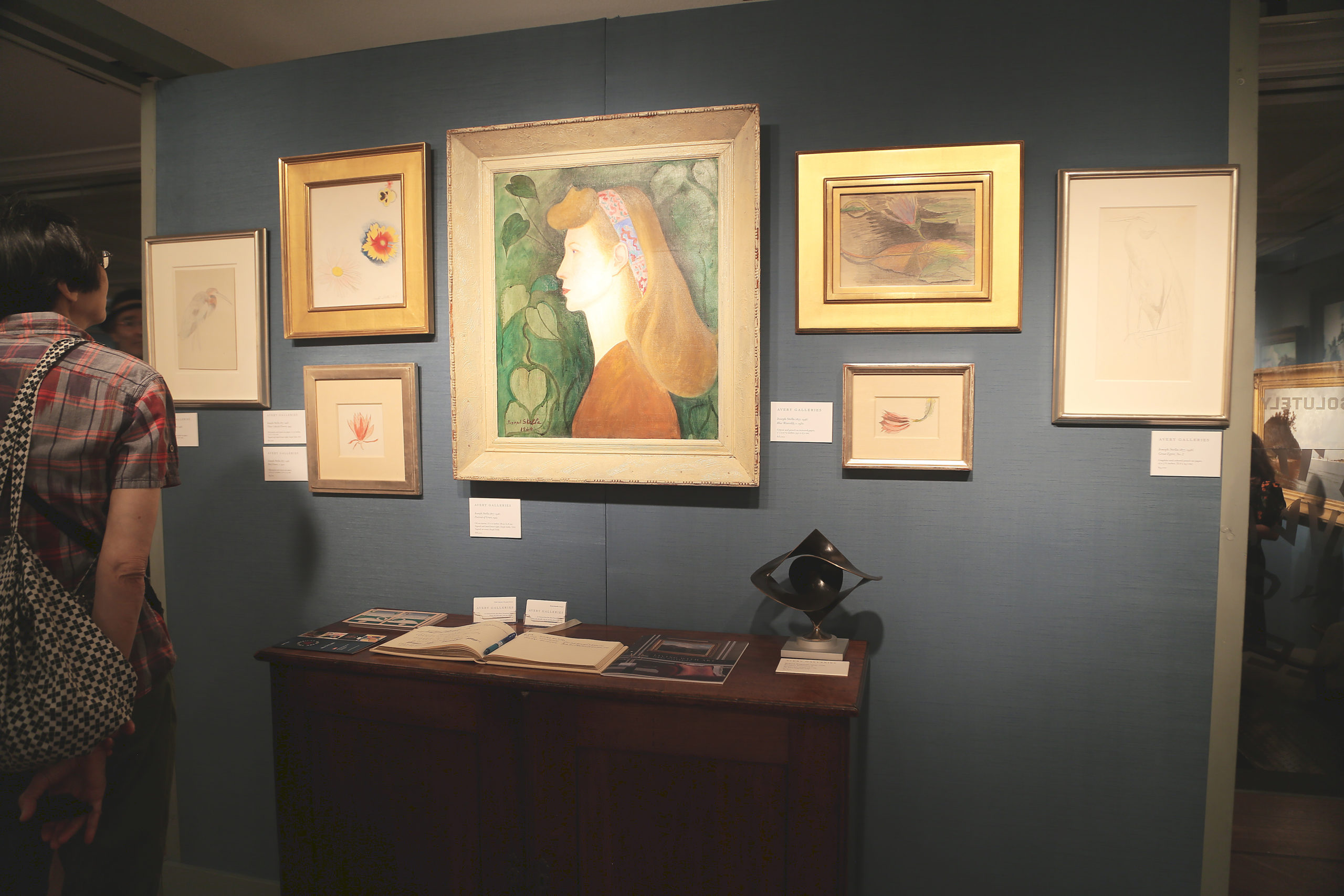
Part of the Joseph Stella mini exhibition with Avery Galleries, Bryn Mawr, Penn.
Shay tallied a half-dozen works during the show, split fairly evenly between two- and three-dimensional pieces. One of his most prominent bronzes — Daniel Chester French’s “The Concord Minuteman” — found a new home, as did “Diana” by Edward Francis McCarten. He had interest and was doing follow up on both “Diana of the Tower” by Augustus Saint-Gaudens and Wilhelm Hunt Diederich’s “The Jockeys.”
Also returning for the second year in a row was James Keny, whose eponymous Columbus, Ohio, gallery featured a range of works from “Tumble of Water,” a Monhegan Island seascape by George Bellows to watercolors by Alice Schille and a dated 1858 earthenware jar by Dave Drake. By the end of the fair, he had sold the Bellows, a freestanding sculpture by Columbus folk artist Elijah Pierce, and Schille’s “Pig Market,” with institutional interest in her “Ranchos de Taos in Full Sun.”
“I greatly enjoy this show and am pleased to be included in a group of well-known dealers of American art,” Keny said. “The limited number of dealers and the intimate setting I think are conducive to thoughtful consideration of the objects on display. Happily, there were many museum-quality objects for sale at the fair.”
He was not the only one to make such an observation.
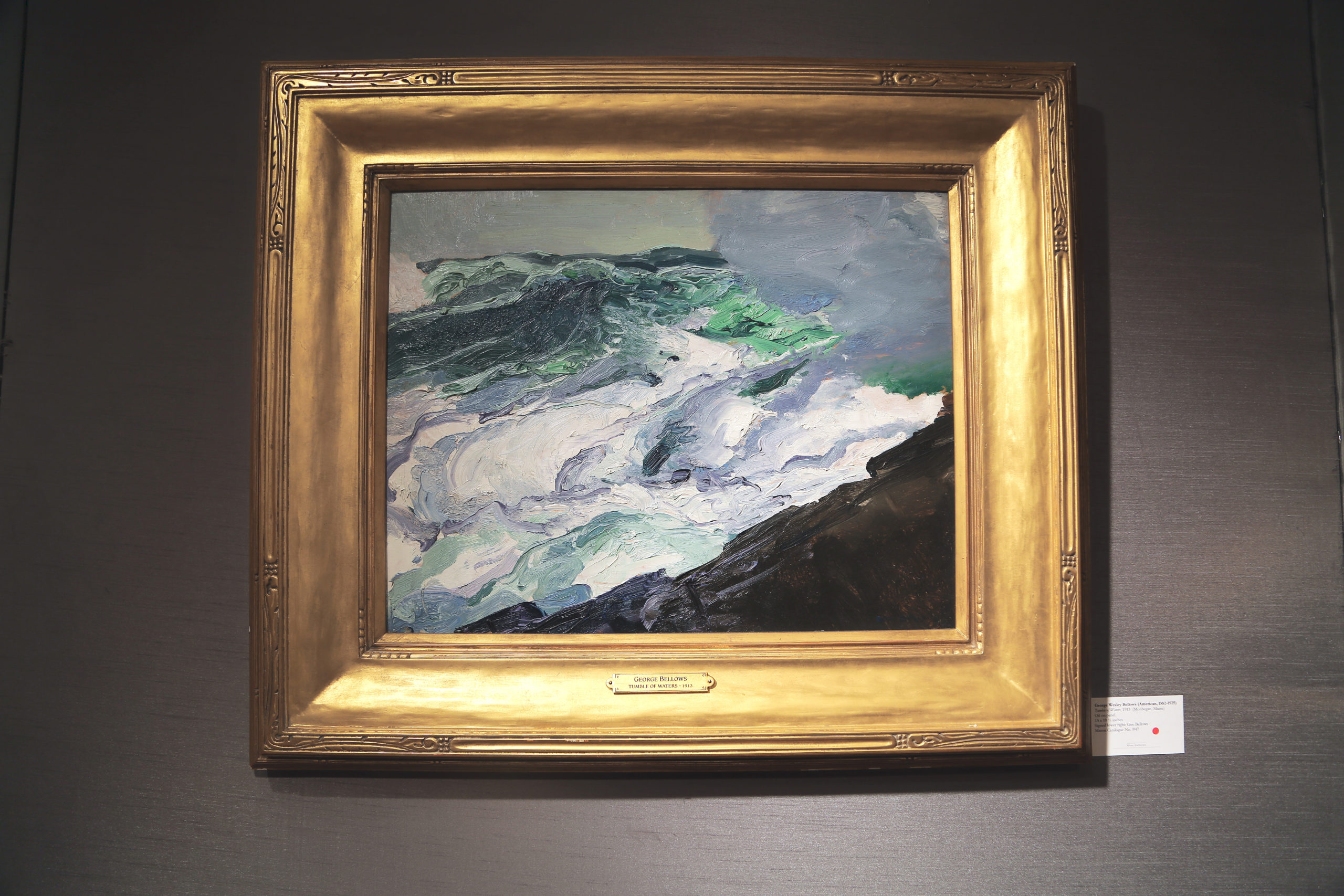
A significant sale during the fair was George Wesley Bellows’ “Tumble of Waters,” painted in Monhegan, Maine, in 1913. Keny Galleries, Columbus, Ohio.
“I like The American Art Fair because the dealers are each sources for historic American art. It is a fair that is an invaluable resource for both old and new collectors. They can see which periods and types of art are considered worthy of considering and who is likely to have those works of art to see or purchase,” said Deedee Wigmore, D. Wigmore Fine Art, who shared her observations about the fair by email. “We experienced lots of engaged people. Those who came were both old and new collectors of something. Many visitors to this fair came open to learning about something new. Those with established collections in the American Impressionist and Post-Impressionist recognized and purchased works that were undervalued by dealers. Wonderful to see collectors circling back to older areas of established art styles. In [our] booth, the American abstract artists of the 1930s-40s received a lot of requests for follow up, and for the Irene Rice Pereira scratch board painting of 1948, like the one in the Guggenheim Museum collection was of interest. Three other pioneers of American abstraction were also a focus for collectors. They were the 1941 Charles Green Shaw oil ‘Composition in Construction,’ the 1936 Gertrude Greene collage, and the Rolph Scarlett watercolors from 1940 and 1941.”
Wigmore’s booth was carefully planned to represent the art styles and periods the gallery buys and sells. It featured works by Shaw, who is the subject of an upcoming gallery exhibit. A selection of 1930s-40s New York architectural subjects demonstrated a balanced inventory of both abstract and realist art, which was rounded out with abstract works by Charles Biederman and Margaret Drewes alongside Sally Michel’s and Doris Lee’s representational paintings.
“We were very pleased with the show,” reported Debra Force. “I thought the attendance was very good — much better than last year, with numerous museum curators and not just from the tri-state area as well as collectors from other parts of the United States.”
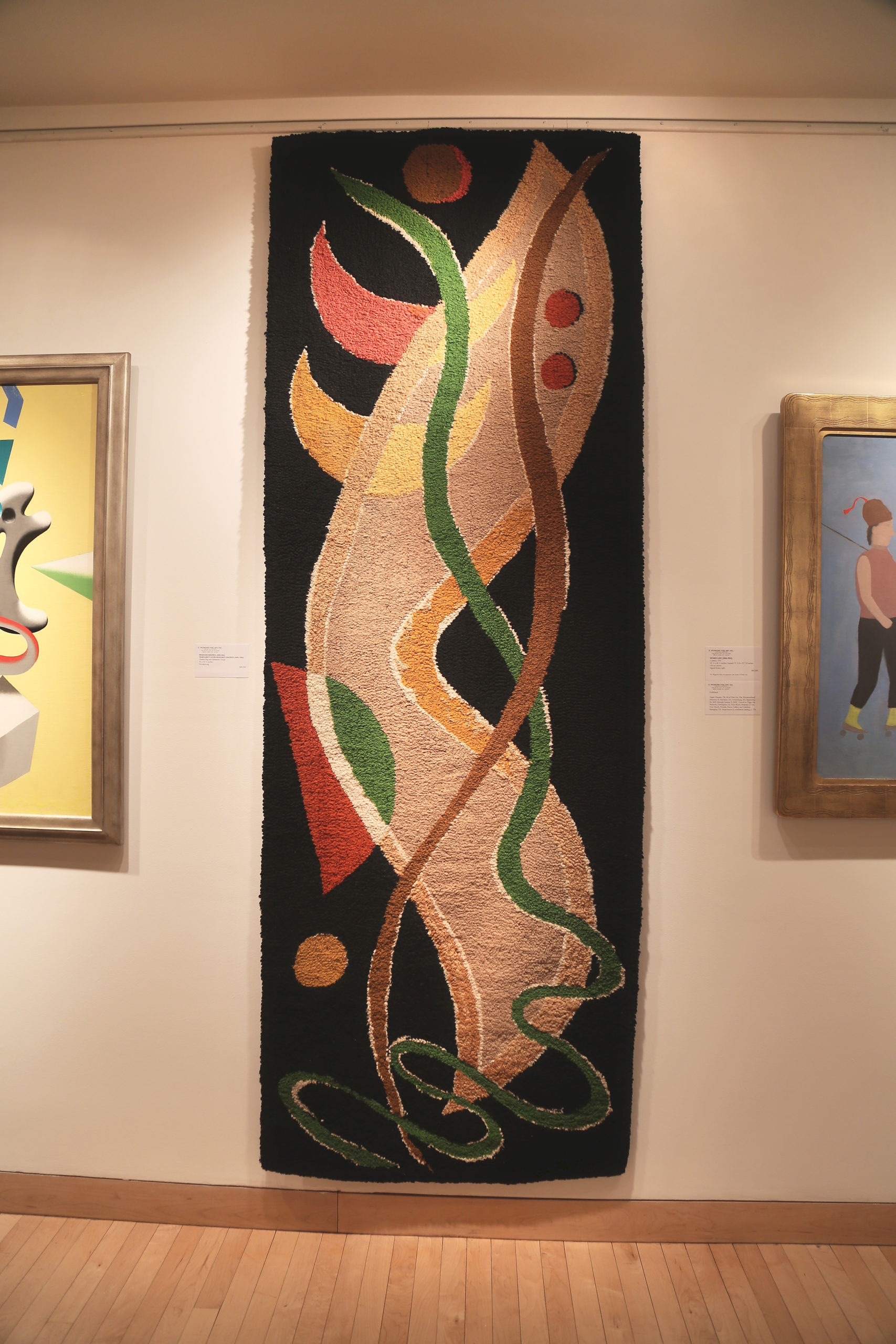
“Hooked rug with Biomorphic Design” by Margaret Drewes, 95 by 33 ½ inches, with D. Wigmore Fine Art, New York City.
Force confirmed she’d sold an undisclosed piece to a museum she hadn’t sold to before but noted that her other sales were largely to people the gallery already knew. One of her most important historical works, which received interest from collectors of that period, was an 1828 portrait of Tagoniscoteyeh (Black Fox) by Charles Bird King. When asked if there were particular styles or periods people were looking at, she noted it depended on the quality of the piece, but generally speaking, modernist and Twentieth Century works “tend to be the most popular,” though she had observed “a stronger market” for Nineteenth Century landscapes.
Boston’s Vose Galleries, which has not participated at TAAF since before the pandemic, returned with an abundance of works, including “The Dunes” by George Elmer Browne, “Grapevine on the Summer House” by Wolf Kahn, “Give us a Ride” by Grandma Moses, Rockwell Kent’s “Alaska” and “Good Harbor Beach, Gloucester,” a 1915 work by Louise Upton Brumback that sold during the fair.
Avery Galleries assembled a small mini exhibition within their booth titled “Lyrical Spirit: The Natural World of Joseph Stella,” which the Bryn Mawr gallery launched in conjunction with an exhibition at the Brandywine River Museum titled “Joseph Stella: Visionary Nature.” A pair of companion paintings of swans by Stella each sold, as well as “Buckland Farm” by Robert Strong Woodward and “They Rode On and On, Winding, Climbing” by Frank E. Schoonover.
The American Art Fair will celebrate its 17th season at the Bohemian National Hall, 321 East 73rd Street, May 18-21. For additional information, www.theamericanartfair.com.


